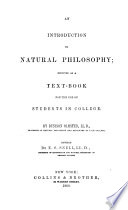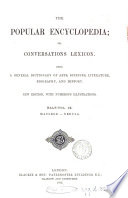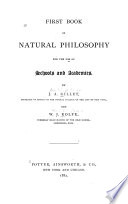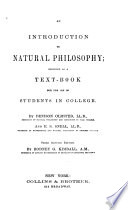 Newton's first law, which states that a body at rest tends to remain at rest, and a body in motion tends to remain in motion in a straight line at a constant speed, unless it is acted on by a force. Newton's first law, which states that a body at rest tends to remain at rest, and a body in motion tends to remain in motion in a straight line at a constant speed, unless it is acted on by a force.  A Text-book of Physics - Page 37by Louis Bevier Spinney - 1911 - 605 pagesFull view A Text-book of Physics - Page 37by Louis Bevier Spinney - 1911 - 605 pagesFull view - About this book
 | Denison Olmsted - Physics - 1860 - 492 pages
...axioms of mechanical science. They may be named and defined as follows: 1. The law of inertia. — A body at rest tends to remain at rest ; and a body in motion tends to move forever, in a straight line, and uniformly. 2. The law of the coexistence of motions. — If several... | |
 | Denison Olmsted - Physics - 1864 - 296 pages
...principles, £j which are to be regarded as the axioms of mechanical science. 1. The law of inertia. A body at rest tends to remain at . rest; and a body in motion tends to continue in motion uniformly, and in a straight line. 2. The law of eo-existence of motions. If several motions... | |
 | Popular encyclopedia - 1877 - 526 pages
...the state of rest or motion of a body is called a force. Newton's first law of motion asserts that a body at rest tends to remain at rest, and a body in motion tends to move in a straight line uniformly, and cannot stop of itself — in fact, that a body at rest remains... | |
 | Joseph Anthony Gillet, William James Rolfe - Physics - 1882 - 210 pages
...the following hour, and so actually go more or less than thirty miles. 41. First Law of Motion. — A body at rest tends to remain at rest, and a body in motion tends to keep moving in the same direction and at the same rate; that is to say, a force must act upon a body... | |
 | Denison Olmsted - Physics - 1882 - 522 pages
...the basis of mechanical science. They may be named and denned as follows : 1. The law of inertia.—A body at rest tends to remain at rest; and a body in motion tends to move forever, in a straight line, and uniformly. 2. The law of the coexistence of motions.—If several... | |
 | Joseph M'Gregor- Robertson - 1884 - 556 pages
...body. The velocity of a body multiplied by its mass gives what is called the momentum of the body. A body at rest tends to remain at rest, and a body in motion tends to remain in motion. To change its state of rest or motion, the application of a force is necessary. This... | |
 | Denison Olmsted - Physics - 1891 - 496 pages
...basis of mechanical science. They may be named and defined as follows : 1. The law of Inertia-.—A body at rest tends to remain at rest ; and a body in motion tends to move forever, in a straight line, and uniformly. That a book allows a paper to be withdrawn from under... | |
 | S. P. Meads - Physics - 1894 - 298 pages
...velocity at top and bottom. Did the ball "of itself" increase its own velocity? First Law of Motion. A body at rest tends to remain at rest, and a body in motion tends to remain in motion with uniform velocity in a straight line. It is scarcely necessary to define motion... | |
 | S. P. Meads - 1896 - 298 pages
...velocity at top and bottom. Did the ball "of itself" increase its own velocity? First Law of Motion. A body at rest tends to remain at rest, and a body in motion tends to remain in motion with uniform velocity in a straight line. It is scarcely necessary to define motion... | |
 | John Francis Woodhull, May Belle Van Arsdale - Physics - 1906 - 152 pages
...recognized by the ammonia test. INERTIA. and apparently does nothing toward stopping the motion of the book. A body at rest tends to remain at rest and a body in motion tends to continue moving. Both of these tendencies are called inertia. EXPERIMENT 16. — Lay a sheet of writing paper... | |
| |